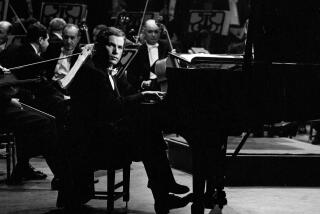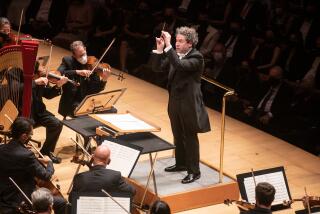L.A. Chamber Orchestra carries on a different holiday tradition: Bach’s Brandenburg Concertos
Complete cycles of Bach’s six wondrous Brandenburg Concertos would be a momentous — and rare — event in the lives of most ensembles and audiences. But this is Los Angeles, and for the Los Angeles Chamber Orchestra, the cycle is almost a routine part of concert life.
Starting in 1979, LACO performances of the Brandenburgs became an annual holiday ritual in the era of music director Gerard Schwarz. The orchestra made an excellent recording of the cycle too, a limited edition of which was released on three 12-inch 45 rpm discs, thus anticipating the current craze for 45 rpm audiophile vinyl by at least 30 years. The frequency of Brandenburg performances eventually tapered off, but still LACO claims to have played the cycle 52 times, more than any other work.
SIGN UP for the free Essential Arts & Culture newsletter »
This month, the Brandenburgs were back in their old holiday slot for performances Nos. 53 through 55, and the week’s wildfires did not seem to have hurt attendance at UCLA’s Royce Hall, which looked almost full Sunday night.
Brandenburg cycles are popular for good reasons: Each concerto is different from the others in instrumentation and the inspiration level is astonishingly high, even for Bach. Perhaps most of all, they radiate joy and swing at a time when stressed shoppers and depressed listeners could use a lift.
It took a while for the group, usually led by concertmaster Margaret Batjer, to get into the swing of things Sunday, though. The Concerto No. 1 sounded ragged in a number of ensemble passages; the Concerto No. 3 got better as it went, with assistant concertmaster Tereza Stanislav weaving a searching violin cadenza around the two chords of the second movement.
Things finally came together in the Concerto No. 5, a de facto showcase for the orchestra’s Baroque artistic partner, the star harpsichordist Mahan Esfahani.
He worked his way through the cadenza with several varieties of rubato, taking the forward-looking chromatic passage at warp speed, setting the continuo pace elsewhere with crispness and bounce. Normally one who prefers his harpsichord au naturel, Esfahani permitted the instrument to be miked for this concerto but it made hardly any audible difference; the sound was still dim, though clear, from the vantage point of Row H.
From this point, the ever-shifting LACO personnel — most of whom played standing — sailed through the even-numbered concertos with greater assurance, getting the rhythms to move and lift the combination of five low strings and harpsichord in the Concerto No. 6. Flutists Joachim Becerra Thomsen and Sandy Hughes made lively work of the lead parts in the Concerto No. 4, and Batjer was just agile enough to nail the violin runs at the ensemble’s fast tempo.
As is apparently LACO’s practice, the Concerto No. 2 came last, showing off David Washburn’s spectacular, exceptionally expressive high-wire trumpet as the can’t-top-this closing act.
From here, the orchestra takes the Brandenburgs to a new locale Thursday night: the Musco Center for the Arts at Chapman University in Orange. That ought to be an even better fit because it’s a smaller hall with excellent acoustics.
♦ ♦ ♦ ♦ ♦ ♦ ♦ ♦ ♦ ♦
LACO and the Brandenburg Concertos
Where: Musco Center for the Arts, Chapman University, 1 University Drive, Orange
When: 7:30 p.m. Thursday
Tickets: $35-$75
Info: (844) 626-8726, muscocenter.org
See all of our latest arts news and reviews at latimes.com/arts.
MORE MUSIC
Bach times two: Collegium and Master Chorale double the elation
A reminder that but a mile separates Disney Hall from skid row
Pasadena Symphony musicians authorize a strike for higher pay
More to Read
The biggest entertainment stories
Get our big stories about Hollywood, film, television, music, arts, culture and more right in your inbox as soon as they publish.
You may occasionally receive promotional content from the Los Angeles Times.






